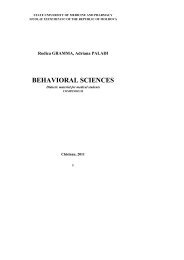Curierul medical, Nr. 5 - Universitatea de Medicină şi Farmacie
Curierul medical, Nr. 5 - Universitatea de Medicină şi Farmacie
Curierul medical, Nr. 5 - Universitatea de Medicină şi Farmacie
Create successful ePaper yourself
Turn your PDF publications into a flip-book with our unique Google optimized e-Paper software.
Nivelurile circulante ale PCR elevează progresiv în primele<br />
72 <strong>de</strong> ore după angioplastie la pacienţii fără <strong>şi</strong> mai accentuat<br />
cu RIS (68 vs 94% faţă <strong>de</strong> nivelul preprocedural), se corelează<br />
cu valorile crescute ale FL-A 2 , dar rămân semnificativ<br />
majorate cu 54 <strong>şi</strong> 68% după 3 (5,7 ± 3,2 mg/L) <strong>şi</strong>, respectiv,<br />
6 (6,2 ± 3,4 mg/L) luni numai la pacienţii care au <strong>de</strong>zvoltat<br />
RIS. La pacienţii fără restenoză PCR este în <strong>de</strong>clin <strong>şi</strong> la perioada<br />
<strong>de</strong> 3 <strong>şi</strong> 6 luni după angioplastie se atestă cu 9 <strong>şi</strong>, respectiv,<br />
18% sub nivelul preprocedural. Astfel, datele noastre aduc<br />
dovezi suplimentare asupra semnificaţiei predictive a creşterii<br />
PCR peste 3 mg/L, după 3 luni <strong>de</strong> zile <strong>de</strong> la angioplastie<br />
privind riscul evoluţiei RIS <strong>şi</strong> rolul procesului inflamator în<br />
formarea <strong>şi</strong> hiperplazia neointimei, substratul morfologic<br />
principal al restenozei.<br />
Numărul <strong>de</strong> macrofagi estimaţi în patternul tisular luminal<br />
al stentului restenozat creşte în raport direct cu gradul<br />
RIS, fiind triplat <strong>de</strong>ja la gradul minim al acesteia (15 vs 5<br />
celule în stentul fără restenoză) <strong>şi</strong> atinge cote medii <strong>de</strong> 156<br />
celule/mm 2 în RIS <strong>de</strong> grad sever. Acumularea macrofagilor<br />
datorită pasajului monocitelor sangvine se corelează inteligibil<br />
cu majorarea PCR <strong>şi</strong>, în special, a FL-A 2 , prin ce se<br />
confirmă rolul inflamaţiei în evoluţia RIS, precum <strong>şi</strong> valoarea<br />
FL-A 2 drept marker al inflamaţiei intravasculare, alterării <strong>şi</strong><br />
disfuncţiei endoteliale.<br />
Bibliografie<br />
1. Popovici I. Optimizarea diagnosticului <strong>şi</strong> tratamentului invaziv prin<br />
evi<strong>de</strong>nţierea predictorilor morfofuncţionali <strong>şi</strong> biochimici ai restenozei<br />
coronariene: Autoref. tezei <strong>de</strong> doctor habilitat în medicină. Chi<strong>şi</strong>nău,<br />
2011.<br />
Particularităţile clinico-evolutive ale bron<strong>şi</strong>tei acute<br />
obstructive la copiii sugari<br />
A. David<br />
8<br />
<strong>Nr</strong>. 5 (329), 2012<br />
2. Buja M. Vascular responses to percutaneous coronary intervention<br />
with bare-metal stents and drug-eluting stents: a perspective based on<br />
insights from pathological and clinical studies. J. Am. Coll. Cardiol.<br />
2011;57(11):1323-1326.<br />
3. Попович И. Роль микро-РНК 143/145 в развитии внутристентового<br />
рестеноза. Kардиология. 2011;9:17-21.<br />
4. Karaca I, Aydin K, Yavuzkir M, et al. Predictive value of C-reactive protein<br />
in patients with unstable angina pectoris un<strong>de</strong>rgoing coronary artery<br />
stent implantation. J. Int. Med. Res. 2005;33(4):389-396.<br />
6. Gomma AH, Hirschfield GF, Gallimore JR, et al. Preprocedural inflammatory<br />
markers do not predict restenosis after successful coronary<br />
stenting. Am. Heart J. 2004;147(6):1071-1077.<br />
7. Kang WC, Ahn TH, Moon CI, et al. Comparison of inflammatory<br />
markers and angiographic outcomes after implantation of Sirolimus<br />
and Paclitaxel eluting stents. Heart. 2009;95:970-975.<br />
8. Lavi S, Lavi R, McConnell HR, et al. Lipoprotein-associated phospholipase<br />
A(2): a review of its role as a marker and a potential participant in<br />
coronary endothelial dysfunction. Mol. Diagn. Ther. 2007;11(4):219-226.<br />
9. Toth PP, McCullough PA, Wegner MS, et al. Lipoprotein-associated<br />
phospholipase A(2): role in atherosclerosis and utility as a cardiovascular<br />
marker. Expert. Rev. Cardiovasc. Ther. 2010;8(3):425-438.<br />
10. Gottsauner-Wolf M, Zasmeta G, Hornykewycz S, et al. Plasma levels<br />
of C-reactive protein after coronary stent implantation. Eur. Heart J.<br />
2000;21:1152-1158.<br />
11. Hoshida S, Nishino M, Takeda T, et al. A persistent increase in C-reactive<br />
protein is a risk factor for restenosis in patients with stable angina who<br />
are not receiving statins. Atherosclerosis. 2004;173:285-290.<br />
12. Niccoli G, Montone R, Ferrante G, et al. The evoluting role of inflammatory<br />
biomarkers in risk assessment after stent implantation. J. Am.<br />
Coll. Cardiol. 2010;56:1783-1793.<br />
13. Ridker P, Danielson E, Fonseca F, et al. Rosuvastatin to prevent vascular<br />
events in men and women with elevated C-reactive protein. New Engl.<br />
J. Med. 2008;359:2195-2207.<br />
14. Jaumdally R, Varma C, Macfadyen R, et al. Coronary sinus blood sampling:<br />
an insight into local cardiac pathophysiology and treatment? Eur.<br />
Heart J. 2007;28:929-940.<br />
Department of Pediatry, Clinic No 1, State University of Medicine and Pharmacy „Nicolae Testemitanu”<br />
7, Serghei Lazo Street, Chisinau, Republic of Moldova<br />
Corresponding author: aladavid01@gmail.com. Manuscript received May 24, 2012; revised October 15, 2012<br />
Clinicly-evolutive features of acute obstructive bronchitis in infants<br />
Chronic obstructive bronchitis is one of the most common diseases of respiratory system in children, being an actual problem, with major influence<br />
on life quality. According to the data from special scientific sources, inci<strong>de</strong>nce is 27-31% at the children of first year of life, gradually <strong>de</strong>creasing with<br />
aging. In publications are evaluated clinicly-evolutive features of chronic obstructive bronchitis in infants. Studying inclu<strong>de</strong>d 161 of children, were divi<strong>de</strong>d<br />
by age in 2 patterns: 1 month, 1 day-6 months – 140 ± 0.49 (86.96%), p < 0,001 and 7-12 months – 21 ± 0.27 (13.04%), p < 0,001 of children. Study<br />
<strong>de</strong>monstrated that clinic evolution of chronic obstructive bronchitis at children in age of 1 month, 1 day – 6 months was more severe, in comparison<br />
with children inn age of 7-2 months.<br />
Key words: acute obstructive bronchitis, clinicly-evolutive features, infants.

















